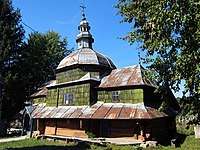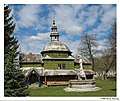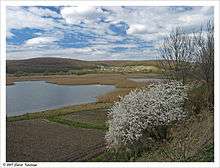Urman, Ukraine
Urman (Ukrainian: Урмань) is a village of 622 people in Berezhany Raion (county) of Ternopil Oblast (province) of western Ukraine. It lies in the historic region of Halychyna (Eastern Galicia) and during 1772-1918 was part of Austrian empire, consequently of Poland in 1920-1939 and of Soviet Union in 1939-1991.

Geography of Urman
Urman is located 15 km to the north from Berezhany. The main part of the village stretches along the river Zolochiv - Berezhany, with river Zolota Lypa nearby, which forms wide pond. We find two Urmans on geographical maps. One is Velykyy Urman (Great Urman - the main part of the village) and other one is Malyy Urman - minor village suburbs, which are situated along the field road, at 2 kilometers to the south from Velykyy Urman´. This suburban part of Urman´ was also called "Na mlynakh" (at the mills), because there was a mill, beyond the pond.
"Urman" means "forest" in Tatar languages (Crimean Tatar and Kazan Tatar). "Urmane" is also old Ukrainian name for Norwegians (mediaeval Varangians / Vikings). One of these two versions might explain the origin of this village name, which is pronounced "oorman" in Ukrainian. It is famous and known first of all because of its nice lake, where many people like to go fishing. The village is situated in beautiful natural surroundings, next to the lake stretched along the alley road, being surrounded by forests. Hills covered with forests (pine, hornbeam, oaks, alder, beech grow here) around Urman are quite high and reach 400 meters. Urman is located on P116 road which connects Berezhany and Zolochiv via Pomoryany. Neighbouring villages are Plikhiv, Rozhadiv, Nadrichne, Zhukiv, Lapshyn (Lapszyn), Pidlisne, Hynovychi, Bishche, Poruchyn, Potoczany, Dryshchiv and Pomoryany.
History
History of Urman is history of Ukraine´s Galician province in miniature. Urman is ancient settlement. Its beginnings reach remote past. We have a documentary mention preserved, that Urman existed already in 1448. Certainly the beginnings of Urman reach much earlier times, maybe even to the duke era of medieval Ukrainian history.
Church in Urman was affiliated with the church in Dryshchiv (Dryszczow in Polish), which is situated at 3 km from Urman Velykyy. But parish priest lived in Urman. The local church in Urman itself is built of wood and is a remarkable piece of wooden architecture. It is consecrated after St Peter and Paul and dates from 1688, according to the inscription, curved out at the doors. It was moved to Urman from Ivano-Frankivsk region (24 pairs of oxen dragged it all the way from Rohatyn according to the legend in 1777).
Population
Urman is not a large village. In 1943, during German rule, it numbered 1900 persons. Currently the village has 622 inhabitants, including 215 houses (2007).







